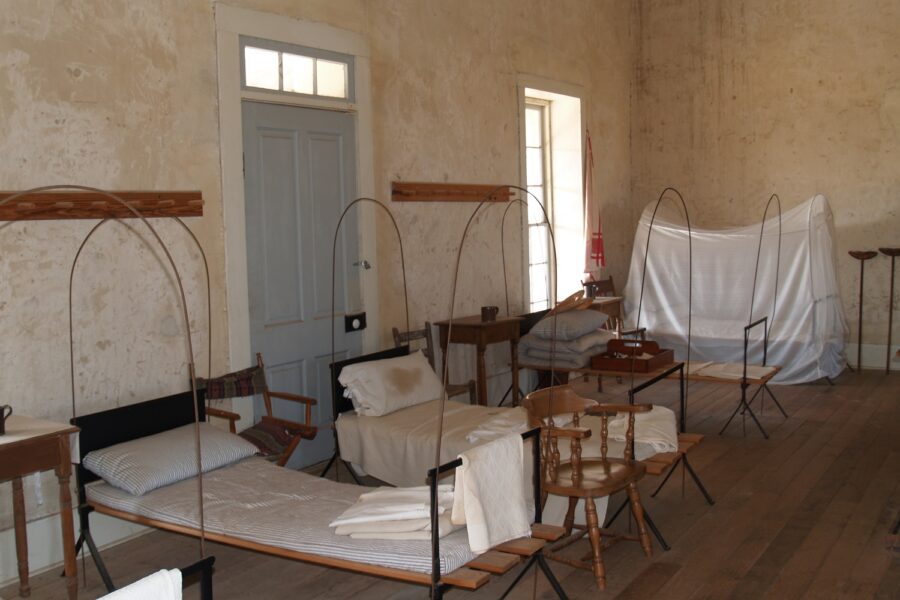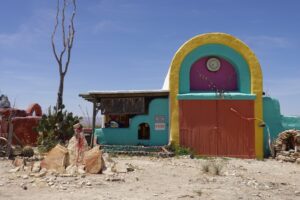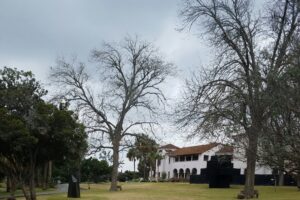The day has almost melted into nothing when we roll into the parking lot of the Fort Richardson Historic Site. The digital clock in my car says 2:02 pm, and we still have a two-hour drive to get back to Abilene. I almost ask Michael why we decided to see two forts in one day—but I know the answer, so I remain silent. Once again, we are the only vehicle taking up space in the parking lot.
Michael is already through the door of the Interpretive Center while I am still outside, trying to photograph the very long building that was the former barracks. Based on its mint condition, I have to believe that the building is a reconstruction of what was.


Officers and non-commissioned officers lived in barracks like the one above. At one time, there were five of these buildings on the fort. In 1875 a report said the roof leaked and the floors were warped. One officer said if you were sitting in front of the fireplace, you would freeze your back and roast your face! Some officers chose to stay in tents.
The Interpretive Center-Museum
Entering the new-old wooden structure of jacal construction, I find Michael sitting and chatting with an official-looking employee of the historic facility. His name is Daryl, and he sits at a table sipping a soft drink—relaxing. I feel like we have intruded on his space, but he is happy to see us. There have been few visitors today. We are informed he will give us a guided tour of the fort if we want. But we have options—to sit in the air-conditioned building and listen to him tell us the fort’s history or walk around outside in 90+ degree heat. The choice is not a hard one.
With memorabilia, photographs, and storyboards in back of us, and a view of the fort through the window, we listen as the story of Fort Richardson unfolds.
History Repeats Itself
The story is a familiar one—the original location chosen was wrong. Wrong. Wrong! After spending two years at Buffalo Springs, about thirty miles north of the current location, that fort was abandoned due to unhealthy conditions. In 1868 the army chose the present site. Eventually, the construction of fifty-five stone, jacal, and lumber buildings was completed. The estimated cost to the government was $800,000—approximately $15,000,000 in today’s money. I wonder if the House of Representatives had to vote on it, and then I can’t help but wish I were a fly on the wall during the ensuing discussion. And I’m also curious to know what would happen today.
Ten years later, the Native Americans had been moved to reservations in Oklahoma and the military abandoned the fort—a need no longer existed.
A Smidgen of Fort Richardson’s History
I learn that not only was Fort Richardson the anchor for the northern line of forts during the first five years of its existence, but it was also strategically the most important post in Texas. Toward the end of those five years, it had the largest garrison of officers and men of any US military installation.
The soldiers were kept busy. Not only did they take part in several major skirmishes with warring Comanche and Kiowa tribes, they also had multiple tasks to perform. They built the post and were responsible for maintaining it. The soldiers assisted local law officers in keeping the peace. They pursued criminals and deserters and escorted wagon trains. It was also their job to oversee elections, protect cattle herds, and patrol for possibly-hostile Native Americans. I’m tired just thinking about it. And they had to do all of these things in the bitter cold of North Texas winters and the unbearable heat of Texas summers wearing the same WOOL uniform! I can almost understand why there would be deserters.
The Museum
Daryl’s spiel is at an end, and he suggests we look at the museum before checking out the rest of the fort—but only if we want to.
We want to.



After finishing our tour of the small museum, Daryl asks if we want to see the hospital. We nod yes. “It’s not air-conditioned,” he warns.
But we are here—and it’s here, so we turn toward the door.
A Tour
I assume that we have been dismissed and are now on our own. So much for assuming. Daryl tells us the building is locked, and he needs to open it for us.
Of the original fifty-five structures on the fort, only seven have been restored. One of the seven includes an imposing building in the near distance that is our destination. Daryl continues to be a font of information as we walk with him toward the original hospital. I decide to walk more slowly and look at things. When I see them standing and waiting, I quickly snap the photograph I want to take and hurry to catch up.


The Hospital
Our guide unlocks the door—even though the building has been closed and is not air-conditioned, it is almost cool. I guess there is a reason for constructing 18-inch-thick walls. Looking at our surroundings, we find ourselves standing in a large room where the beds remind me of miniature covered wagons. It is one of the wards for patients. We begin learning the whys and wherefores of what we see.



Designed to patch up soldiers wounded in battle, we are informed that hospital staff treated over and above these war wounds. They saw more illnesses and deaths caused by bad water, spoiled food, alcoholism, and venereal diseases than anything else.
Along with two patient wards, there is also a kitchen, dining rooms, washrooms, a dispensary, and a surgeon’s office. We visit all of them and learn more than I can possibly ever remember. I’m not sure how Daryl does. He keeps saying he is a caretaker and only does this when needed—Michael and I don’t believe him.



An hour later, we are back where we started, and Daryl asks if we would like to see the rest of the fort. We look at the time; the clock says no. Our aching backs agree.
Thanking our guide for all he has done and all we have learned, we point our noses toward Abilene and dinner. We never had lunch, and our breakfast taco was a long, long time ago.
Fort Richardson Today
Now owned and operated by the Texas State Parks and Wildlife Department, most of the land is devoted to parks and recreation. The historic fort is the icing on the cake.
Entrance Fees
- Adult: $4 Daily
- Child 12 Years and Under: Free
- Group Adult: $2 Daily
Hours
Open daily.
When checking into the fort, be sure to ask about guided tours.
Reservations are highly recommended for both camping and day use. To guarantee entry, reserve passes online or by calling the customer service center before you visit.
To see more stories on other Forts, click on the following link:
https://www.charlottestexashillcountry.com/category/texas-beyond-the-hills/texas-forts/









Leave a Reply
Your email is safe with us.